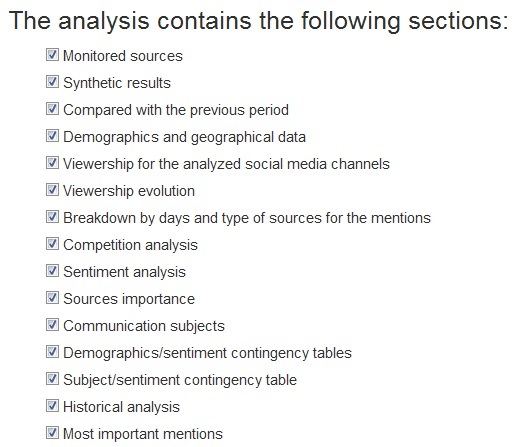Project overview
I. GENERAL ISSUES
What is Zelist Monitor?1
What is Zelist Monitor used for?2
Who is Zelist Monitor recommended to?3
What does Zelist Monitor monitor?4
I am missing an article from the monitoring. What is the explanation?5
Why don't you monitor all aggregators?6
II. INTERFACE DESCRIPTION
Homepage description - Monitored expressions1
What is the workflow for Zelist Monitor?2
Why are groups helpful?3
How do I introduce expressions for monitoring?4
Do I introduce expression with or without diacritics?5
Can the introduced expressions be modified?6
How do the introduced expressions differ according to the monitoring module?7
How do I receive the monitoring results?8
Demographic and geographical statistics9
What is the Viewership?10
What is the estimaned Viewership of a mention?11
How is the (estimated) Viewership of a mention computed?12
How is the average traffic estimated for Zelist blogs that are not enrolled on Trafic.ro?13
How is the (estimated) Viewership graphically represented?14
What is the impact of a mention?15
How is the Viewership of a social media channel computed?16
What is the importance of a source and how is it computed?17
What is the relevance of a mention and how can I change it?18
What does the sentiment represent?19
How can I use tags?20
Tagcloud: the brand's radiography in social media21
Filter of results22
Multiple marking in the filtration of appereances23
Filtered results can be exported24
Favourite articles can be sent via e-mail25
What can we find in the Influencers sub-menu?26
Customs lists27
Alert + Daily/weekly summary facility28
How do I set alerts in Romanian?29
Automatic analysis presentation30
Graphic customization of automatic analysis31
How do I add an analysis in Romanian?32
Sections of the automatic analysis33
Methods of exporting the content and of using it with other applications34
Methods of directly integrating the content in other applications35
Collaborative work and sub-user accounts36
Task management37
What is Social Media Campaigns Monitor?38
Alerts In Social Media Campaigns Monitor39
Social Media Insights40
.roBlogs Index, .roTwitter Index, .roFacebookIndex, .roOnline_press Index41
II.
33.
33.
Sections of the automatic analysis
The operator can choose the following chapters for the analysis:
1. Monitored sources: presents statistical data about the activity of the blogosphere, the twittosphere and the online press in the study period;
2. Synthetic results: briefly presents the number of posts about the monitored expression that have appeared on each social media channel and the afferent percentages: for blogs, Twitter and the online press.
3. Compared to the previous period: starting from the length of the period for which the analysis is made, a comparative analysis is performed for the same expression, but in 2 different time periods: present and previous.
4. Demographics and geographical data: presents demographic and geographical data for the persons that have mentioned the monitored expression.
5. Viewership for the analyzed social media channels: presents the estimated number of people who were exposed to the message on each social media channel.
6. Viewership evolution: presents the evolution of the estimated number of persons that were exposed to the message on each social media channel (in the last month)
7. Breakdown by days and types of sources of the mentions: presents the number of posts that appeared on each media channel in each day of the analyzed period.
8. Analysis of the competition: presents the evolution of the monitored brand in comparison with the evolution of competitors in the same time period.
9. Sentiment analysis: is the qualitative analysis of posts appeared related to the monitored expression. Using a 5 level scale , starting at "very unfavorable" and ending with "very favorable", we measure the attitude towards the monitored expression (towards a brand, for example), in each post in which it was mentioned.
Depending on the specific of the source, the context of the article which mentions the monitored expression, the linguistic flexions in the post, the operator determines the general feeling for each post and at the end of the monitoring period the general feeling towards the brand will be known, a positive, negative or neutral one.
10. Importance of the sources: presents the distribution of sources that made references to the monitored expression, taking into consideration the Zelist relevance index.
11. Subjects of communication: presents the main subjects, themes and contexts in which the monitored expression was mentioned. This analysis is realised with the help of tags.
12. Demographics/sentiment contingency tables: present the link between the following variables: "gender" and "sentiment", "age" and "sentiment" and " region" and "sentiment".
13. Subject/sentiment contingency table: presents the number of very favorable, favorable, neutral, unfavorable and very unfavorable mentions for each subject.
14. Historical analysis: presents the evolution (text and graphic) of the expression's visibility in the last year.
15. Most important mentions - detailed presentation of the most important mentions.
